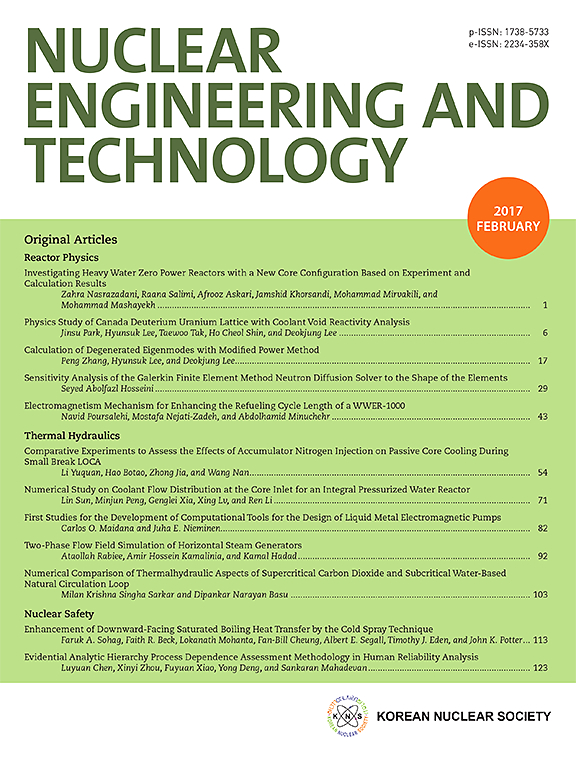Experimental analysis of jet expansion geometry and the influence of pressure waves on the behavior of air discharge processes in subcooled stagnant water
IF 2.6
3区 工程技术
Q1 NUCLEAR SCIENCE & TECHNOLOGY
引用次数: 0
Abstract
Gas jet discharges into liquid media are extensively studied due to their relevance in several industrial processes. They are fundamental in nuclear reactor safety and venting systems, where they play roles in overpressure relief, fission product retention, and aerosol scavenging. The presence of pressure waves in these discharges significantly influences the behavior of the process, determining certain aspects of the jet dynamics. This study focuses on understanding the distribution and propagation of pressure waves within the jet, as they can generate shock waves that alter the geometry, trajectory, and conditions of the jet, introducing additional instabilities and complexities. To conduct this analysis, the JEBEA experimental facility was utilized, performing overexpanded and underexpanded discharges through nozzles with inner diameters ranging from 2 to 6 mm. Direct visualization techniques were employed using a high-speed camera to capture image sequences. Subsequently, image processing methods provided detailed information on the jet dynamics and the influence of pressure waves. Results indicate that shock waves generated near the nozzle significantly impact the intensity and frequency of instabilities in the discharges, varying notably between overexpanded and underexpanded conditions, with frequencies ranging from 5 to 40 Hz in overexpanded jets and 1–11 Hz in underexpanded jets.
过冷滞水中射流膨胀几何形状及压力波对排气过程影响的实验分析
气体喷射排放到液体介质中由于其在几个工业过程中的相关性而被广泛研究。它们是核反应堆安全和排气系统的基础,在超压释放、裂变产物保留和气溶胶清除中发挥作用。这些放电中压力波的存在显著地影响了过程的行为,决定了射流动力学的某些方面。这项研究的重点是了解压力波在射流中的分布和传播,因为它们可以产生冲击波,改变射流的几何形状、轨迹和条件,带来额外的不稳定性和复杂性。为了进行分析,利用JEBEA实验设备,通过内径为2至6mm的喷嘴进行过膨胀和欠膨胀放电。采用直接可视化技术,利用高速摄像机捕捉图像序列。随后,图像处理方法提供了有关射流动力学和压力波影响的详细信息。结果表明,喷管附近产生的激波对放电不稳定性的强度和频率有显著影响,在过膨胀和欠膨胀条件下变化明显,过膨胀射流的频率为5 ~ 40 Hz,欠膨胀射流的频率为1 ~ 11 Hz。
本文章由计算机程序翻译,如有差异,请以英文原文为准。
求助全文
约1分钟内获得全文
求助全文
来源期刊

Nuclear Engineering and Technology
工程技术-核科学技术
CiteScore
4.80
自引率
7.40%
发文量
431
审稿时长
3.5 months
期刊介绍:
Nuclear Engineering and Technology (NET), an international journal of the Korean Nuclear Society (KNS), publishes peer-reviewed papers on original research, ideas and developments in all areas of the field of nuclear science and technology. NET bimonthly publishes original articles, reviews, and technical notes. The journal is listed in the Science Citation Index Expanded (SCIE) of Thomson Reuters.
NET covers all fields for peaceful utilization of nuclear energy and radiation as follows:
1) Reactor Physics
2) Thermal Hydraulics
3) Nuclear Safety
4) Nuclear I&C
5) Nuclear Physics, Fusion, and Laser Technology
6) Nuclear Fuel Cycle and Radioactive Waste Management
7) Nuclear Fuel and Reactor Materials
8) Radiation Application
9) Radiation Protection
10) Nuclear Structural Analysis and Plant Management & Maintenance
11) Nuclear Policy, Economics, and Human Resource Development
 求助内容:
求助内容: 应助结果提醒方式:
应助结果提醒方式:


